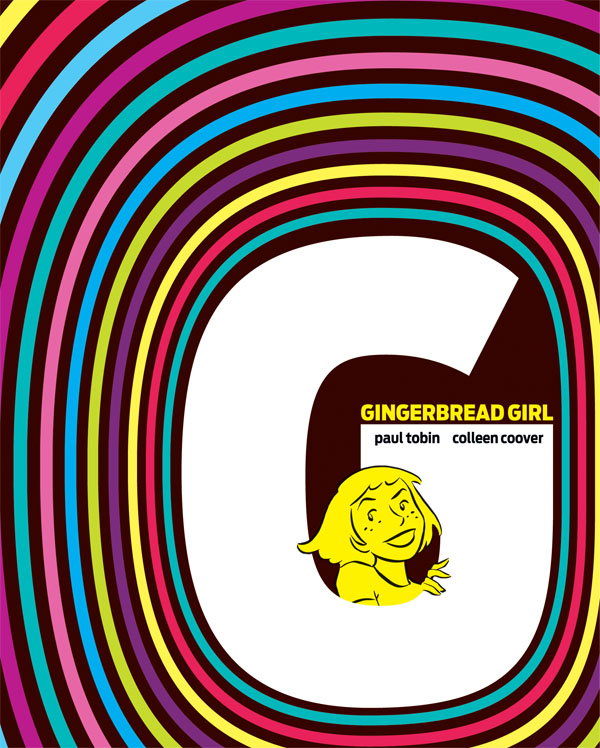In another boon for digital comics, you can now find Top Shelf comics on Graphicly! Always one of our favorite publishers, we’re glad to see their work now more widely available. To celebrate the launch, Top Shelf have offered some crazy deals on their books this week.
For $8.99, you can pick up the complete Gingerbread Girl graphic novel by husband and wife creative team Paul Tobin and Colleen Coover. It’s a great value for one of the year’s most playful and inventive character studies. There are many ways to reveal character. Through action. Through words. But one of the most telling ways is by exploring her relationships. Here, Annah Billips is revealed to us through the people in her life. And maybe a pigeon or two.
There are many verifiable facts concerning 26-year-old Annah Billips. She likes sushi and mountains and piglets, but hates paper cuts and beer breath. She flirts with girls and boys, and loves to travel. She might have a missing sister… or she might be totally insane. Did Annah invent an imaginary sister named Ginger during her parents’ traumatic divorce? Or did her mad scientist father extract part of her brain and transform it into a living twin? In this whimsical, thought-provoking graphic novel, a host of narrators (including boyfriends, girlfriends, neighbors, bystanders, magicians, and passing animals) try their best to unlock the mystery of Annah… and the Gingerbread Girl.
We talked to Tobin and Coover about digital comics and why Gingerbread Girl first started in a digital format.
iFanboy: Has the advent of digital publishing changed the way you look at comic storytelling or your approach to designing a page?
Paul Tobin: It really hasn’t YET changed the way that I approach a page, but I know that it’s going to. The tool set of digital comics has been changing at such a rate that it’s hard to know what’s in the tool box, so that every sort of experimentation is outdated almost before it exists. I know that eventually I’m going to want to be able to expand the moments of the panels… delve into some aspect of interactivity. At the same time, it’s a delicate line. One of the real glories of comics is that comics are ALREADY interactive: a reader will naturally “fill in” the moments between panels, gearing the story according to his or her own preferences and biases, and I think we, as creators, need to be careful not to step on those toes.
Colleen Coover: I like the fact that digital distribution allows creators to make comics of whatever length they want, and release them to the entire world, immediately. For example, if you have a story that’s only seven pages long, you can go ahead and make it seven pages without having to worry whether or not you’ll ever find an anthology to publish it in. Or a two-page story. Or a longer story that you want to do in serialized installments. You can create stories of any genre you like. You can change genres from story to story. You can do whatever you want.
iF: Many readers of Gingerbread Girl first experienced that book digitally on the Top Shelf website before the print edition became available. Pages were released on a staggered schedule similar to new installments from a webcomic. Can you talk a bit about the decision to promote the book this way? Is it an approach that could benefit other books?
PT: I was just on a panel the other day with Katie Cook, a fellow creator whose artwork I adore, and she was talking about how she really doesn’t make any money off her webcomics… BUT… when it came time to collect all her webcomics into a tangible book, she had something like 1000 preorders, instantly making the book viable. THAT’S what’s so amazing about the internet: every single installment of Gingerbread Girl that we put online was an advertisement for the work itself. And I do think there are other books that can benefit from the process. I think the more story-oriented, the better. There’s little reason to buy a portfolio, for instance, if every page of it is available online.
CC: And because Gingerbread Girl doesn’t really fit into any particular genre, it’s a big ask for people to take the risk on picking up the physical book, sight unseen. By giving them the option of checking it out in advance, they could say, “Yes, I want this.”
iF: Much has been said with regard to the opportunity for experimentation afforded by digital publishing, from alternative layouts to imbedded video and animation. Do you see yourselves drawn to this kind of experimentation or dedicated to traditional comic formats and methods?
PT: A little of both. It entirely depends on the story in front of me. An action story could really explode off the page with additions of animations, and horror stories can become creepier, and so on. Again, though… I think we have to be wary of putting too many computer bells & whistles on a comic book page. We need to add to the art form while still preserving the art form. It’ll be an interesting dance.
CC: I’m very excited by the possibilities in storytelling. Like Paul said, it would be easy to go over the top, but I think there will be some very clever people making great comics that will surprise us. I’d like to do some of that myself, when I get the chance to really sit down and think about how I’d go about it.
Disclaimer: iFanboy is owned by Graphicly.



Just read about half the book over at Top Shelf. Will pick up tomorrow at my LCS!